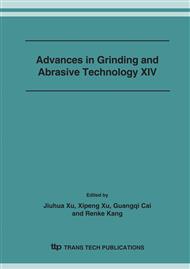p.533
p.538
p.543
p.548
p.554
p.559
p.564
p.569
p.574
On Programming for NC Grinding of Grooved Cam with Discretional Plane Curve Profile
Abstract:
In grinding of grooved cam, the programming for NC machining can’t directly be accomplished according to track curve of roller center in working drawing because the diameter of wheel becomes smaller than diameter of cam’s follower roller after wheel dressing. Track curves of wheel center are equidistant curves of the track curve of roller center and they can be gained by equidistant offset. But track curves of wheel center can’t be gained by equidistant offset for grooved cam with discretional plane curve profile, due to the profile including aspheric curves whose equations are usually unknown. To solve above problem, circular arc approximation for the aspheric curve part was realized by using Approximate Double Circular Arc Interpolated Method (ADCAIM), then equidistant offset of circular arcs was carried out by “offset” way, and consequently track curves designed for wheel center of any diameter can expediently be gained on AutoCAD platform. Validation experiment of simulation grinding was fulfilled on a NC milling machine. The experiment results indicate: it is feasible to NC grind grooved cam with discretional plane curve profile using the method introduced in this paper for the example.
Info:
Periodical:
Pages:
554-558
Citation:
Online since:
November 2007
Authors:
Price:
Сopyright:
© 2008 Trans Tech Publications Ltd. All Rights Reserved
Share:
Citation:


